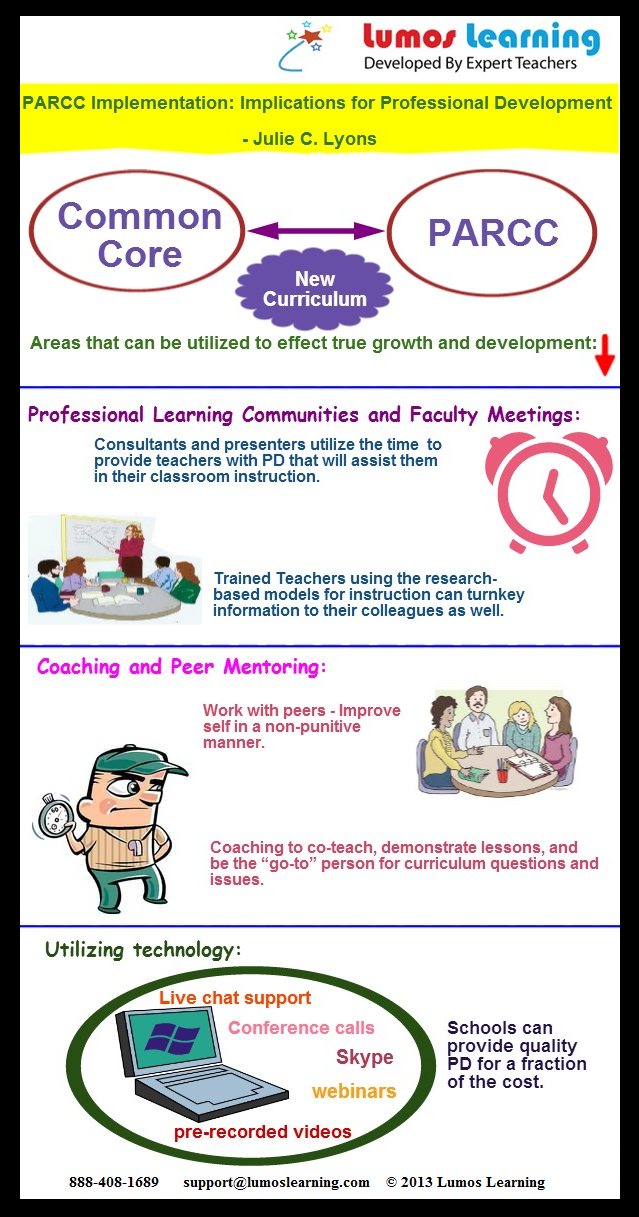Return To Teachers Speak

Over the past few weeks, we have investigated the connection between the Common Core and the future state assessment (Partnership for Assessment of Readiness for College and Careers, PARCC). With these changes comes realigned curriculam: clearly, what teachers teach must reflect the new standards, and past curriculum guides may have proven outdated or in need of tweaking.
However, even the most well-planned curriculum will be little more than a document without true implementation at the classroom level. In other words, students will truly benefit from the Core when instruction, standards, curriculum and assessment intersect. For this reason, professional development will need to take a front seat, as effective PD has the potential to provide teachers the support they need to understand, help them become comfortable with the changes, and guide them as they translate theory into practice. To maximize the benefits of professional development, let’s investigate the following three areas that can be utilized to effect true growth and development:
Professional Learning Communities and Faculty Meetings.
Most schools provide common planning time or meetings for their teachers, whether this takes place as a grade level, entire staff, or within a particular content area. Regardless of structure, this time can be utilized to bring in consultants and presenters to provide teachers with professional development that will assist them in their instruction and day-to-day classroom routines. Alternately, teachers who have been trained and are using research-based models for instruction can turnkey information to their colleagues as well.
For example, one middle school in South Jersey uses its PLC time and faculty meetings to read and discuss Marzano’s teaching strategies to better inform faculty of best practices in teaching and learning. Teachers have the opportunity to view videos of teachers utilizing strategies, reflect on their own practice, and discuss ways to apply what they are learning to their own classrooms.
Coaching and/or Peer Mentoring/Observations.
With peer observations, teachers can receive feedback without the pressure that often accompanies formal administrative evaluations. By working with a peer, the teacher can concentrate on his or her craft in a non-punitive manner. Both teachers benefit from this infusion of new ideas, and by having that objective observer in the room, the teacher will also become aware of elements of the lesson that may otherwise go undetected – such as which students were off-task, how well the teacher managed the time, the number of times s/he called on particular students, etc. With two people in the room, a much more robust picture emerges of what was happening in the classroom during the lesson.
Coaching is another avenue some schools have taken, hiring master teachers to spend their days traveling to different classrooms to observe teachers, co-teach, demonstrate lessons, and be the “go-to” person for curriculum questions and issues. Jim Knight of the University of Kansas spent years researching the effectiveness of coaches and found that “an estimated 95% of teachers who receive ongoing support and guidance through coaching are more likely to learn and implement new practices in the classroom” (from the West Virginia Department of Education’s Collegial Coaching Toolkit). Coaching is a
promising option for schools that truly want to enact systemic change and build capacity for best practices and new programs.
Utilizing technology.
Hiring consultants and other presenters can become costly and time-consuming for a district, but with technology, schools can provide quality PD for a fraction of the cost. Between conference calls, live chat support, Skype, webinars, and pre-recorded videos, parcc professional development opportunities are becoming more accessible, convenient and affordable. Now, teachers can watch videos in the comfort of their own homes, play and pause videos during a meeting to discuss what they’re viewing, and receive real-time feedback from experts from across the globe – without having to arrange flights and visitations for these experts.
Clearly, variables such as a district’s budget, school schedules, teacher contract parameters, etc. will dictate which ideas are feasible for its staff. However, it would benefit all stakeholders to investigate PD ideas with an open mind, for a willingness to think “outside the box” may enable staff to pursue new ideas that may have more lasting change than former professional development efforts.
Like any other educational change, the more teachers have a voice, the greater a district’s chances for achieving instructional fidelity, too. If curriculum supervisors and administrators approach this somewhat daunting task as an organic process, they will be able to adjust and adapt their plan according to what has worked in the past, what is
working now, and what needs to change to improve for the future. With a multi-faceted strategy to help educators grow professionally, districts can be assured that they are being comprehensive in their approach to bridging the gap between the Common Core, state assessments, curriculum and instruction.


